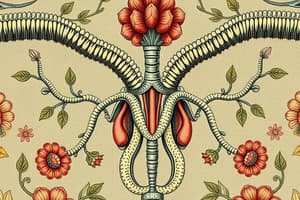Podcast
Questions and Answers
What type of glands have multiple ducts, each with several sacs-like secretory portions?
What type of glands have multiple ducts, each with several sacs-like secretory portions?
- Simple tubular glands
- Compound tubular glands
- Compound acinar glands (correct)
- Compound tubuloacinar glands
Which type of secretion involves the release of secretory products by exocytosis?
Which type of secretion involves the release of secretory products by exocytosis?
- Holocrine secretion
- Merocrine secretion (correct)
- Apocrine secretion
- Endocrine secretion
What type of connective tissue primarily consists of collagen fibers and a few elastic fibers?
What type of connective tissue primarily consists of collagen fibers and a few elastic fibers?
- Areolar connective tissue (correct)
- Reticular connective tissue
- Dense regular connective tissue
- Adipose connective tissue
Which cells form fibrous connective tissue?
Which cells form fibrous connective tissue?
What type of secretion involves the shedding of entire cells?
What type of secretion involves the shedding of entire cells?
Which cells in connective tissue release chemicals to promote inflammation?
Which cells in connective tissue release chemicals to promote inflammation?
Which type of gland has ducts that secrete substances onto an epithelial surface?
Which type of gland has ducts that secrete substances onto an epithelial surface?
What is the function of osteoblasts in connective tissue?
What is the function of osteoblasts in connective tissue?
Which type of connective tissue cell is responsible for the production of collagen fibers?
Which type of connective tissue cell is responsible for the production of collagen fibers?
What do exocrine glands secrete into the body?
What do exocrine glands secrete into the body?
In connective tissue, which cell type is involved in immune response by releasing histamine?
In connective tissue, which cell type is involved in immune response by releasing histamine?
Which characterizes the secretion process of exocrine glands?
Which characterizes the secretion process of exocrine glands?
What is the location of adipocytes in the human body?
What is the location of adipocytes in the human body?
Which type of protein fibers can return to their original shape after being stretched or compressed?
Which type of protein fibers can return to their original shape after being stretched or compressed?
Where is dense irregular connective tissue located in the human body?
Where is dense irregular connective tissue located in the human body?
Which connective tissue type has relatively few protein fibers and numerous spaces filled with ground substance?
Which connective tissue type has relatively few protein fibers and numerous spaces filled with ground substance?
What is the primary function of reticular connective tissue?
What is the primary function of reticular connective tissue?
Where can dense regular elastic connective tissue be predominantly found?
Where can dense regular elastic connective tissue be predominantly found?
Study Notes
Glandular Types and Secretion Mechanisms
- Compound glands possess multiple ducts, each containing several sac-like secretory portions.
- Merocrine secretion involves the release of products via exocytosis without cell damage.
- Holocrine secretion entails the shedding of entire cells, releasing their contents.
Connective Tissue Characterization
- Dense connective tissue primarily consists of collagen fibers with some elastic fibers.
- Fibroblasts are the cells responsible for forming fibrous connective tissue.
- Osteoblasts play a crucial role in bone formation by producing the bone matrix.
Immune Response and Chemical Release
- Mast cells in connective tissue release chemicals that promote inflammation and initiate immune responses.
- Exocrine glands transport secretions through ducts to epithelial surfaces, maintaining direct contact with the external environment.
Connective Tissue Cell Functions
- Collagen fiber production is primarily carried out by fibroblasts within connective tissue.
- Adipocytes are primarily located in adipose tissue throughout the body, particularly in subcutaneous areas.
- Elastic fibers can be stretched or compressed and return to their original shape, providing flexibility.
Locations and Functions of Connective Tissue
- Dense irregular connective tissue is located in areas such as the dermis of the skin, providing structural support.
- Areolar connective tissue features relatively few protein fibers, abundant ground substance, and supports organs and tissues.
- Reticular connective tissue's primary function is to form a supportive framework for organs, particularly in lymphoid tissues.
Structures of Elastic Connective Tissue
- Dense regular elastic connective tissue is predominantly found in structures requiring elasticity, such as the walls of large arteries and certain ligaments.
Studying That Suits You
Use AI to generate personalized quizzes and flashcards to suit your learning preferences.
Description
Test your knowledge on the structure and secretion types of exocrine glands. Learn about compound acinar and compound tubuloacinar glands, along with merocrine, apocrine, and holocrine secretions.




